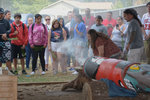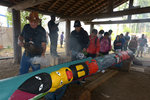

Teens at the Nisqually Youth and Community Center spent part of the summer restoring a 100-year-old totem pole to its former glory.
Farron McCloud, Nisqually Youth and Community Center supervisor, will help the youth assemble a time capsule to put in the base of the pole.
Plans for a pole raising ceremony are being made when the totem will be installed in front of the youth center, said Debbie Preston, public information officer for Nisqually Indian Tribe in an email.
Bringing some expertise into the mix, Nisqually hired Quinault Indian Nation Master Carver Guy Capoeman to supervise the kids.
Capoeman said he worked closely with the teens while they identified faded animals, shapes and symbols.
“I enjoyed all if it, but especially the sanding,” said Nathaniel Wells, 15. “The top of the pole was also a bit of a mystery. It was fun to think of whether it was a fox or rabbit. The teamwork was nice — I liked that we did it together.”
“It was amazing,” Maleah Broussard, 15, said. “I can tell my future family what I did here and I loved coming together to do it.”
There was a lot to do on the pole before the pole could be painted, Capoeman said.
First, they had to clean up and remove decayed wood that got in the way of clean paint lines, he said.
And before they got painting in full, they had to identify the colors used originally, as best they could. They identified a black, two different reds, a bluish green, a gray and a brown.
“I marked those (colored) areas on the pole for the kids, and they went in and started to paint all the shapes, animals and objects,” Capoeman said. “Then I came in and did some detail work, with some volunteers from the village as well.”
Looking back on the project, Capoeman said that what Nisqually Indian Tribe is doing with its youth is superb.
“I just want to encourage Nisqually and their youth to keep on this track,” Capoeman said. “I mean culture and youth go hand-in-hand, and I applaud Nisqually for what they are doing with their youth and involving them in projects like this. My hands go up to them.”
He said that when youth participate in projects that are history based, it helps them draw a better connection to their ancestors, to their identities.
Which is also what totem poles are supposed to do, he said.
“Totem poles are synonymous with the Pacific Northwest… but more as house posts, interior decorative spiritual items that may have had some connection to the owner of the home,” Capoeman said. “Among the Salish-speaking tribes, which Nisqually is one of, the poles would tell the story of one’s relationship with his land, ancestors and environment.”
The pole originally belonged to the Kleiner family, of Tacoma, including Morris Kleiner, his son Herman, his daughter-in-law Barbara and his daughters Josephine and Malca.
Three to four years after Morris Kleiner purchased and named Liberty Lumber Company in 1914, he bought a “genuine Alaskan Indian totem pole from an Alaskan fisherman,” said Herman Kleiner.
Morris Kleiner erected the pole in front of his shop, and it remained there until 1942, when it was moved to a second Kleiner business, Model Lumber Company, after the closing of Liberty Lumber Company.
The pole stayed outside of Model Lumber Company until 1972, when it was moved to Fife after the business relocated. Then, in 1985, the Kleiners donated the pole to the Tacoma Metropolitan Park Board, thinking that it would have a good second life in the Point Defiance Zoo.
Herman Kleiner said that the pole never received sufficient maintenance at the zoo, though many interested parties gave it a shot. At some point, the pole became lost in the park, until it was found in the grasses in 2012.
Sometime afterwards, the Nisqually Tribe agreed to take the pole as a gift.
“We’ve awakened this pole in our community,” McCloud said. “It will be wonderful when we are able to raise this in front of the youth center.”